10 fascinating natural phenomena and why they happen every summer
Temperatures get warmer — and heatwaves are more common.

The Arctic Circle enjoys 24 hours of light.
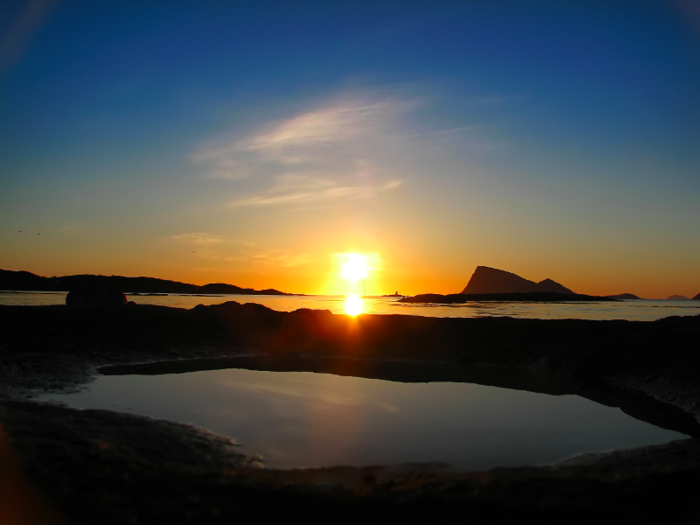
North of the Arctic Circle, or above 66 degrees in latitude, the sun is visible for 24 hours a day for a given time-frame depending on how far north you are. And at the North Pole, it will be daylight all day from March 21 to September 23. This phenomenon is popularly called the “Midnight Sun,” and it too a result of the axial tilt.
While at the equator, the sun seems to rise straight up into the sky and set straight down at the horizon, back in the far north latitudes, the sun appears to travel in a slanting 360 degree circle in the sky. So, even when the sun is below the horizon, it isn’t there for very long, nor is it very far below the horizon, keeping the sky alight all night long.
The southern hemisphere experiences all the above phenomena too, just on the reciprocal side of the calendar.
The stars that we see at night change.
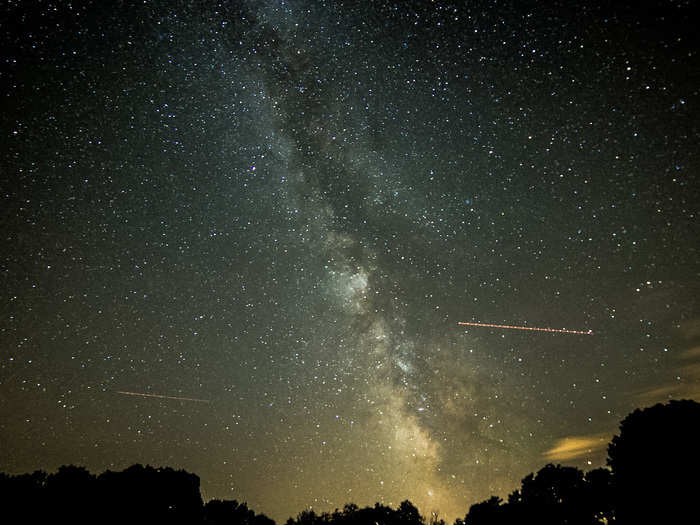
As the earth orbits the sun, the part of the night sky that is in our view changes. What this means is that most of the star patterns, or constellations, that we see on a summer night are different from those that we see in the winter, according to Space.com. In other words, in the summer, we can see the stars that during the winter were in our daytime sky, and thus were invisible to us.
Of course, this change in which stars we see doesn’t happen all at once. The change in the night sky is subtle from night to night, But, as the season progresses, reports Space.com, a given star sets about 4 minutes earlier each night, so over a month, that means it sets two hours earlier. Gradually, the stars that were low over the western horizon during the early evening hours eventually disappear entirely from our view over a few weeks and their place is taken up stars that earlier were higher in the sky at sundown.
Since the planet completes a circle every year, patterns and constellations re-emerge on schedule every season. For example, it’s a great time to see the Big Dipper in the summer.
Thunderstorms are more frequent.
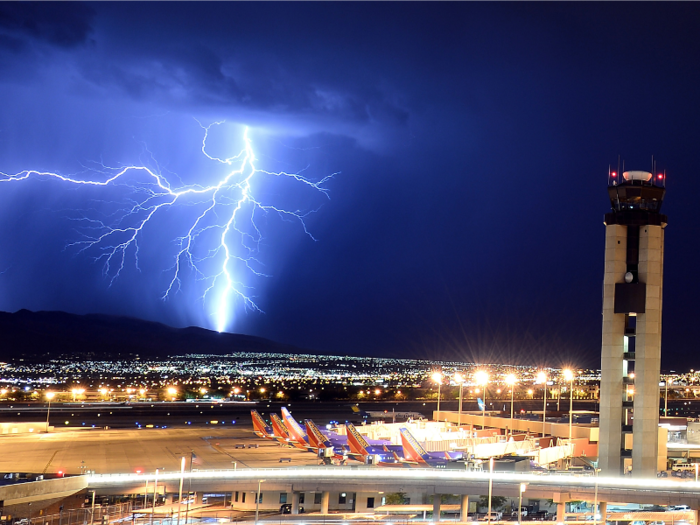
Thunderstorms — characterized by rain showers, thunder, and lightning — can occur year-round, according to NOAA, but they are much more prevalent and generally more severe in the warmer months of summer. This is because moisture and rapidly rising warm air play an important role in forming these storms: High humidity and warm temperatures result in large amounts of warm, moist air air rising into the atmosphere.
As the moisture rises, condensation occurs and water droplets form as they reach the colder temperatures of the high altitudes. Some of the rapidly rising moisture freezes in the upper cloud regions. While evaporation and condensation continues, turbulence is created and droplets of moisture collide with one another, knocking off electrons and creating charge separation. The newly-knocked off electrons gather at the lower portion of the cloud (giving a negative charge) and the rising moisture carries a positive charge to the top of the cloud. The violent process continues until the positive and negative difference is so great that a conductive path is formed, creating lightning, which is the high-voltage, high current surge of electrons.
Lightning bolts are so hot at the core rapidly that they heat the air as they pass through it. This, followed by a rapid cooling after the bolt passes, creates intense sound waves that we call thunder.
Fire rainbow clouds are sometimes spotted on summer days.
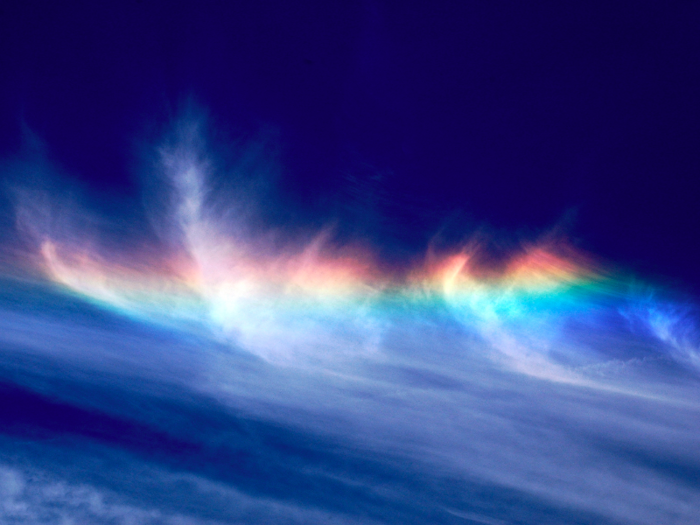
Fire rainbows, technically known as circumhorizontal arcs, are distinctive clouds, easily recognized due to their bright rainbow colors and flame-like shape. These ice halos are formed by hexagonal, plate-shaped ice crystals that occur in high level cirrus clouds. The halo is so large that the arc appears parallel to the horizon.
The clouds occur mainly during the summer months at particular latitudes because the sun has to be at a very precise position in the sky — an elevation of 58 degrees or higher — in order for the rainbow colors to appear. When the sun is at this position, sunlight enters the clouds’ ice crystals and is refracted (split) into individual colors, just as light does when it passes through a prism.
The location of the observer is also important, which is why fire rainbow clouds cannot be seen in latitudes north or south of 55 degrees.
And after sunset, night-shining clouds sometimes appear.
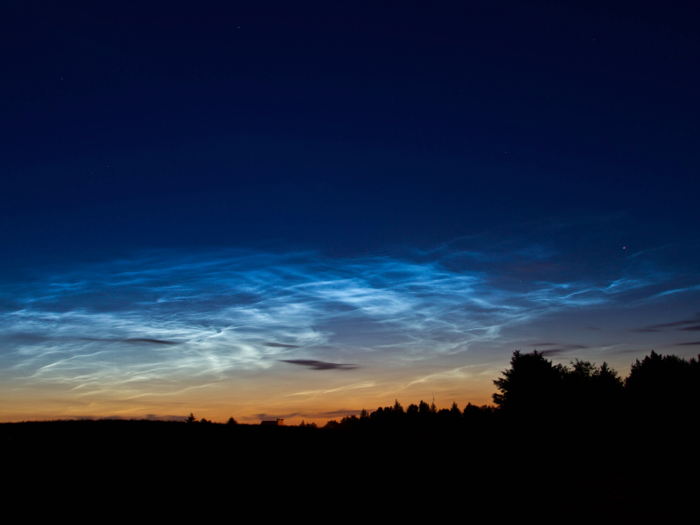
Also known as noctilucent clouds, night-shining clouds are tendril-like with a blueish tinge. They are usually visible against a darkening, summer skies.
These clouds hang at the edge of space, and are formed from tiny ice crystals approximately 50 miles high above the earth in the upper part of the mesosphere. The ice crystals only form this high when the air gets extremely cold (minus 190 degrees Fahrenheit) and these conditions only occur in the high mesosphere during the summer months near the poles. This happens because the polar regions heat up during the summer and the relatively warm, wet air rises, expanding rapidly which causes it to cool rapidly as well. The ice particles that make up these clouds actually “seed” on meteoric smoke, according to NASA, which is comprised of tiny, floating remnants of meteors that burned up entering Earth’s atmosphere.
Fireflies congregate at dusk and synchronize their flashing light patterns.
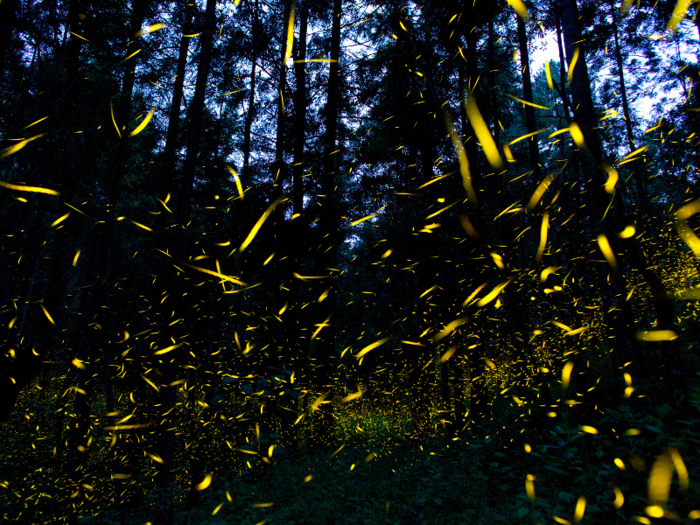
At dusk in the summer, large numbers of fireflies gather for just a few weeks every year and can be spotted, blinking in perfect unison — creating a beautiful, dramatic spectacle.
Fireflies, also called lightning bugs, are beetles and their light patterns are part of their mating display — the patterns are unique to each species of firefly, helping male and females recognize each other. The production of the light in these beetles is an example of bioluminescence, and, according to the National Park Service, it occurs when fireflies combine the chemical luciferin and oxygen with the enzyme luciferase in their ‘lanterns’ (a part of their abdomens) in order to glow.
These fireflies can be seen at Santa Clara Sanctuary in Mexico in July. In the US, the creatures can be spotted as far north as Philadelphia, but the largest gathering of these blinking creatures occurs at Great Smoky Mountains National Park.
Tiny turtles hatch from their shells and make a quick dash to the ocean.
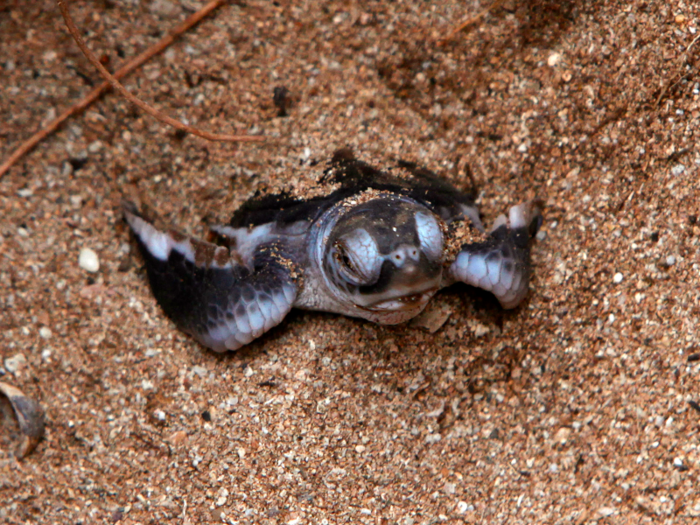
In the summer, pregnant female sea turtles crawl out of the ocean onto beaches, dig a nest in the sand, and lay as many as 100 eggs in sandy nests before retreating back into the water. These eggs will then incubate in the warm sand for an average of 60 days, according NOAA, though the exact incubation time varies with the species of sea turtle. The hatchlings will then begin to break out of their eggs, though they will remain in their nests for several days, absorbing their yolk for energy. Then, en masse, the hatchlings climb out of their nests in a coordinated effort and rush to the ocean while trying to avoid waiting predators on the beach.
Turtle hatchlings are often seen this time of year in Florida, Costa Rica, Mexico, and Turkey.
Whales are spotted feeding along northern coastlines.
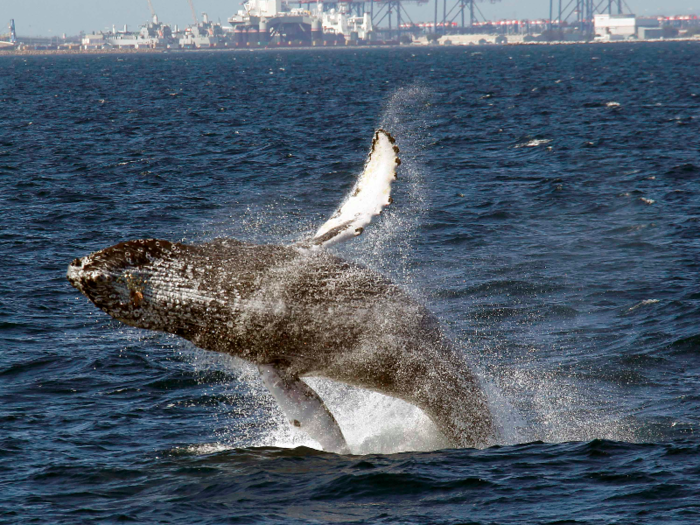
Summer is prime whale-watching season because a large number of whales migrate to their popular feeding grounds along northern coastlines.
For example, every summer, humpback whales feed in the high-latitude waters near the Gulf of Maine in the Atlantic Ocean, as well as the Gulf of Alaska in the Pacific, reports NOAA. As baleen whales, they eat mostly tiny crustaceans, such as krill and plankton. This species of whale is always popular with whale watchers because they perform aerial displays while they feed. They are often seen breaching the water or slapping the surface with their long pectoral fins, tails, or heads in order to gather up large amount of krill and plankton. Other species that are sometimes spotted in these same summer feeding grounds include Minke, Finback and Right Whales.
And salmon swim upriver to their birthplace to spawn.
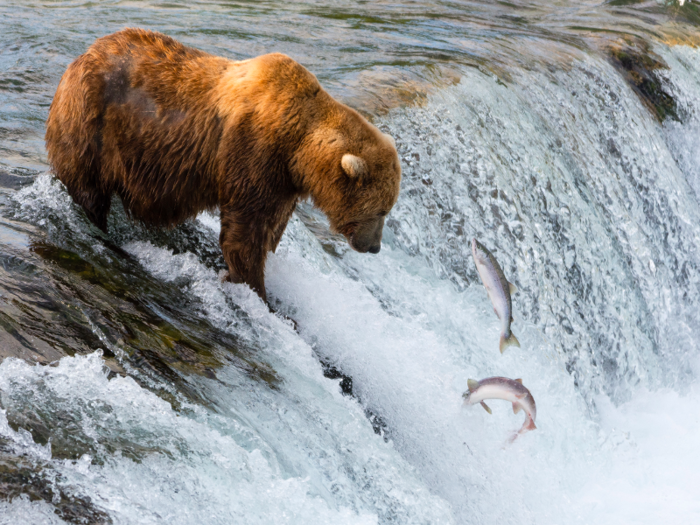
Every year, salmon migrate back from the ocean and swim upriver to their birthplace in order to spawn. Depending on the river and the species of salmon, this phenomenon starts in the summer and continues into the fall. Once the fish have made this long and exhausting journey and spawned, they die.
This annual phenomenon attracts a large number of hungry predators, including bald eagles and grizzly bears, that converge on the rivers to catch their next meal. For example, in Alaska’s Katmai National Park, large numbers of brown bears gather at waterfalls in July just to catch the swimming fish.
Popular Right Now
Popular Keywords
Advertisement